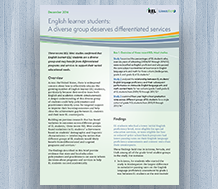English Learners — Diverse Group Deserves Differentiated Services: New Research Report
Posted on

Across the United States, there is concern about how to effectively educate the growing number of English language learner (ELL) students, particularly because ELLs need to learn both English and academic content simultaneously.
This brief, produced by REL West’s English Learner Alliance, synthesizes three recent studies that found variations in ELL students’ achievement based on students’ demographic and linguistic characteristics, such as:
- Socioeconomic status
- Eligibility for special education services
- Initial English proficiency level
- Grade level
- Time of first designation as an ELL student
- Time of reclassification as English proficient
